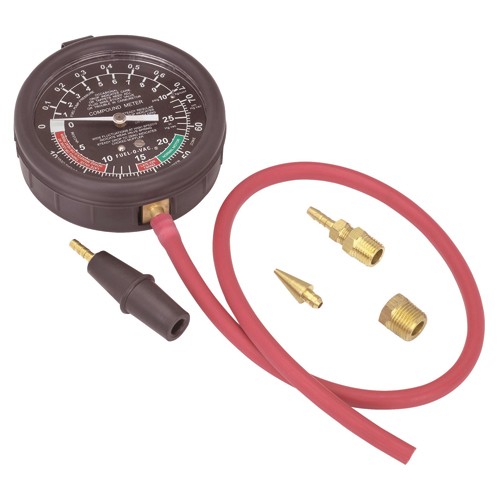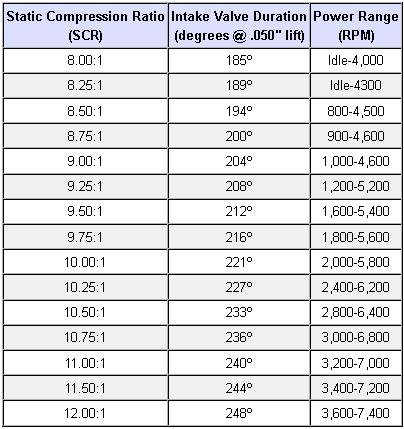mathd
solid fixture here in the forum
Hey, here is some formula i found on the net, keep in mind they are approximate just for a WILD GUESS
(first one is by Larry Meaux) to find the DST(Dynamic Stroke) for calculing your DCR using the cam timing data.
Now, if we use the formula with my engine.
a 383 4.030 bore, 3.75 stroke, 76cc head, a 41 ABDC intake valve closing, 5.7" rod lenght, 18cc piston
the give something like that
rd = 1.875 * (sine 41) = 1.23
rr = 1.875 * (cosine 41) = 1.41
pr1 = Square root (5.7 X 5.7) - (1.23 X 1.23) = 5.56
pr2 = 5.56 - 1.41 = 4.15
dst = 5.7 - ((4.15 + 1.875) - 5.7) = 3.425
If we plot 3.425 as the stroke value into the Compression Ratio Calculator it give a 7.65 DCR(without boost obviously)
You can plot the DST value instead of the true Stroke in the CR calculator (http://www.rbracing-rsr.com/compstaticcalc.html)
Lets say i want to assume max HP using some CFM value
Lets say the 882 head flow about 205 CFM at max intended intake valve lift.
A real short formula for non boost/power adder to have a wild guess at the hp/head flow ratio:
intake head flow x .25 x cylinder numbers = wild hp guess.
205 x .25 x 8 = 410 hp. < very wild guess/no max rpm.
Now lets get more realistic and take accound the VE% because its a boosted app, the MAX RPM and the engine C.I. displacement.
lets say i have a 383 with a max RPM of 6000 and a VE% of 1.32%
(C.I. displacement) x (max RPM) x .5 x VE% / 1728 = Engine max CFM flow
383ci x 6000 x .5x 1.32 / 1728= Engine CFM flow(877CFM)
now most head manufacturer assuve a 1.67 CFM per 1 HP(or 2 to 2.2 for stock/mild app).
so
877CFM / 1.67 = about 525 FlyWheel HP.
Assuming a 15% drivetrain loss
525 x .85 = 446.25 RWHP
Now,
If i want to average what carb CFM rating would good.
i have once again a 383 that run a max of 6000 rpm with a VE% or around 1.32
(C.i. displacement) x (max rpm) / 3456 x VE% = CFM rating
383 ci x 6000 / 3456 X 1.32VE% = 877 CFM
OR
(C.i. displacement) x (max rpm) / 3456 x (Boost PSI / 14.7) +1 = CFM rating
The last one seem less accurate but is from holley.
Now, keep in mind those are wild guess.
Feel free to Edit/delete my post.
(first one is by Larry Meaux) to find the DST(Dynamic Stroke) for calculing your DCR using the cam timing data.
Code:
RD = Rod horizontal Displacement in inches
ICA = advertised Intake Closing timing (Angle) in degrees ABDC
RR = Rod Distance in inches below crank CL
RL = Rod Length
PR1 = Piston Rise from RR in inches on crank CL.
PR2 = Piston Rise from crank CL
ST = STroke
1/2ST = one half the STroke
DST = Dynamic STroke length to use for DCR calcs
What's going on: First we need to find some of the above variables. We need to calculate RD and RR. Then, using these number, we find PR1 and PR2. Finally, we plug these number into a formula to find the Dynamic Stroke (DST).
Calcs:
RD = 1/2ST * (sine ICA)
RR = 1/2ST * (cosine ICA)
PR1 = sq root of ((RL*RL) - (RD*RD))
PR2 = PR1 - RR
DST = ST - ((PR2 + 1/2ST) - RL)a 383 4.030 bore, 3.75 stroke, 76cc head, a 41 ABDC intake valve closing, 5.7" rod lenght, 18cc piston
the give something like that
rd = 1.875 * (sine 41) = 1.23
rr = 1.875 * (cosine 41) = 1.41
pr1 = Square root (5.7 X 5.7) - (1.23 X 1.23) = 5.56
pr2 = 5.56 - 1.41 = 4.15
dst = 5.7 - ((4.15 + 1.875) - 5.7) = 3.425
If we plot 3.425 as the stroke value into the Compression Ratio Calculator it give a 7.65 DCR(without boost obviously)
You can plot the DST value instead of the true Stroke in the CR calculator (http://www.rbracing-rsr.com/compstaticcalc.html)
Lets say i want to assume max HP using some CFM value
Lets say the 882 head flow about 205 CFM at max intended intake valve lift.
A real short formula for non boost/power adder to have a wild guess at the hp/head flow ratio:
intake head flow x .25 x cylinder numbers = wild hp guess.
205 x .25 x 8 = 410 hp. < very wild guess/no max rpm.
Now lets get more realistic and take accound the VE% because its a boosted app, the MAX RPM and the engine C.I. displacement.
lets say i have a 383 with a max RPM of 6000 and a VE% of 1.32%
(C.I. displacement) x (max RPM) x .5 x VE% / 1728 = Engine max CFM flow
383ci x 6000 x .5x 1.32 / 1728= Engine CFM flow(877CFM)
now most head manufacturer assuve a 1.67 CFM per 1 HP(or 2 to 2.2 for stock/mild app).
so
877CFM / 1.67 = about 525 FlyWheel HP.
Assuming a 15% drivetrain loss
525 x .85 = 446.25 RWHP
Now,
If i want to average what carb CFM rating would good.
i have once again a 383 that run a max of 6000 rpm with a VE% or around 1.32
(C.i. displacement) x (max rpm) / 3456 x VE% = CFM rating
383 ci x 6000 / 3456 X 1.32VE% = 877 CFM
OR
(C.i. displacement) x (max rpm) / 3456 x (Boost PSI / 14.7) +1 = CFM rating
The last one seem less accurate but is from holley.
Now, keep in mind those are wild guess.
Feel free to Edit/delete my post.




